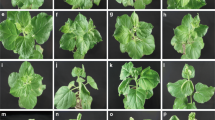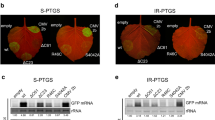Abstract
Many plant viruses encode suppressors of RNA silencing, including the helper component-proteinase (HC-Pro) of potyviruses. Our previous studies showed that a D-to-Y mutation at amino acid position 193 in HC-Pro (HC-Pro-D193Y) drastically attenuated the virulence of clover yellow vein virus (ClYVV) in legume plants. Furthermore, RNA-silencing suppression (RSS) activity of HC-Pro-D193Y was significantly reduced in Nicotiana benthamiana. Here, we examine the effect of expression of heterologous suppressors of RNA silencing, i.e., tomato bushy stunt virus p19, cucumber mosaic virus 2b, and their mutants, on the virulence of the ClYVV point mutant with D193Y (Cl-D193Y) in pea. P19 and 2b fully and partially complemented Cl-D193Y multiplication and virulence, including lethal systemic HR in pea, respectively, but the P19 and 2b mutants with defects in their RSS activity did not. Our findings strongly suggest that the D193Y mutation exclusively affects RSS activity of HC-Pro and that RSS activity is necessary for ClYVV multiplication and virulence in pea.






Similar content being viewed by others
References
Atsumi G, Kagaya U, Kitazawa H, Nakahara K, Uyeda I (2009) Activation of the salicylic acid signaling pathway enhances Clover yellow vein virus virulence in susceptible pea cultivars. Mol Plant Microbe Interact 22:166–175
Brigneti G, Voinnet O, Li W, Ji L, Ding S, Baulcombe D (1998) Viral pathogenicity determinants are suppressors of transgene silencing in Nicotiana benthamiana. EMBO J 17:6739–6746
Burgyan J, Havelda Z (2011) Viral suppressors of RNA silencing. Trends Plant Sci 16:265–272
Chang M, Horovitz D, Culley D, Hadwiger L (1995) Molecular cloning and characterization of a pea chitinase gene expressed in response to wounding, fungal infection and the elicitor chitosan. Plant Mol Biol 28:105–111
Goto K, Kobori T, Kosaka Y, Natsuaki T, Masuta C (2007) Characterization of silencing suppressor 2b of cucumber mosaic virus based on examination of its small RNA-binding abilities. Plant Cell Physiol 48:1050–1060
Hamilton A, Baulcombe D (1999) A species of small antisense RNA in posttranscriptional gene silencing in plants. Science 286:950–952
Ido Y, Nakahara KS, Uyeda I (2012) White clover mosaic virus-induced gene silencing in pea. J Gen Plant Pathol. doi:10.1007/s10327-012-0360-3
Kasschau K, Carrington J (1998) A counterdefensive strategy of plant viruses: suppression of posttranscriptional gene silencing. Cell 95:461–470
Kasschau K, Xie Z, Allen E, Llave C, Chapman E, Krizan K, Carrington J (2003) P1/HC-Pro, a viral suppressor of RNA silencing, interferes with Arabidopsis development and miRNA function. Dev Cell 4:205–217
Lakatos L, Csorba T, Pantaleo V, Chapman E, Carrington J, Liu Y, Dolja V, Calvino L, López-Moya J, Burgyán J (2006) Small RNA binding is a common strategy to suppress RNA silencing by several viral suppressors. EMBO J 25:2768–2780
Masuta C, Yamana T, Tacahashi Y, Uyeda I, Sato M, Ueda S, Matsumura T (2000) Development of clover yellow vein virus as an efficient, stable gene-expression system for legume species. Plant J 23:539–546
Morel J, Godon C, Mourrain P, Béclin C, Boutet S, Feuerbach F, Proux F, Vaucheret H (2002) Fertile hypomorphic ARGONAUTE (ago1) mutants impaired in post-transcriptional gene silencing and virus resistance. Plant Cell 14:629–639
Morita-Yamamuro C, Tsutsui T, Sato M, Yoshioka H, Tamaoki M, Ogawa D, Matsuura H, Yoshihara T, Ikeda A, Uyeda I, Yamaguchi J (2005) The Arabidopsis gene CAD1 controls programmed cell death in the plant immune system and encodes a protein containing a MACPF domain. Plant Cell Physiol 46:902–912
Mourrain P, Béclin C, Elmayan T, Feuerbach F, Godon C, Morel J, Jouette D, Lacombe A, Nikic S, Picault N, Rémoué K, Sanial M, Vo T, Vaucheret H (2000) Arabidopsis SGS2 and SGS3 genes are required for posttranscriptional gene silencing and natural virus resistance. Cell 101:533–542
Nakabayashi H, Yamaji Y, Kagiwada S, Ugaki M, Namba S (2002) The complete nucleotide sequence of a Japanese isolate of white clover mosaic virus strain RC. J Gen Plant Pathol 68:173–176
Omarov R, Sparks K, Smith L, Zindovic J, Scholthof H (2006) Biological relevance of a stable biochemical interaction between the tombusvirus-encoded P19 and short interfering RNAs. J Virol 80:3000–3008
Pontier D, Godiard L, Marco Y, Roby D (1994) hsr203J, a tobacco gene whose activation is rapid, highly localized and specific for incompatible plant/pathogen interactions. Plant J 5:507–521
Ravelo G, Kagaya U, Inukai T, Sato M, Uyeda I (2007) Genetic analysis of lethal tip necrosis induced by Clover yellow vein virus infection in pea. J Gen Plant Pathol 73:59–65
Ruiz-Ferrer V, Voinnet O (2009) Roles of plant small RNAs in biotic stress responses. Annu Rev Plant Biol 60:485–510
Sato M, Masuta C, Uyeda I (2003) Natural resistance to Clover yellow vein virus in beans controlled by a single recessive locus. Mol Plant Microbe Interact 16:994–1002
Scholthof H, Scholthof K, Jackson A (1996) Plant virus gene vectors for transient expression of foreign proteins in plants. Annu Rev Phytopathol 34:299–323
Shiboleth Y, Haronsky E, Leibman D, Arazi T, Wassenegger M, Whitham S, Gaba V, Gal-On A (2007) The conserved FRNK box in HC-Pro, a plant viral suppressor of gene silencing, is required for small RNA binding and mediates symptom development. J Virol 81:13135–13148
Suzuki M, Kuwata S, Kataoka J, Masuta C, Nitta N, Takanami Y (1991) Functional analysis of deletion mutants of cucumber mosaic virus RNA3 using an in vitro transcription system. Virology 183:106–113
Syller J (2005) The roles and mechanisms of helper component proteins encoded by potyviruses and caulimoviruses. Physiol Mol Plant Pathol 67:119–130
Takahashi Y, Takahashi T, Uyeda I (1997) A cDNA clone to clover yellow vein potyvirus genome is highly infectious. Virus Genes 14:235–243
Takeda A, Sugiyama K, Nagano H, Mori M, Kaido M, Mise K, Tsuda S, Okuno T (2002) Identification of a novel RNA silencing suppressor, NSs protein of Tomato spotted wilt virus. FEBS Lett 532:75–79
Torres M, Dangl J, Jones J (2002) Arabidopsis gp91phox homologues AtrbohD and AtrbohF are required for accumulation of reactive oxygen intermediates in the plant defense response. Proc Natl Acad Sci USA 99:517–522
Torres MA (2010) ROS in biotic interactions. Physiol Plant 138:414–429
Voinnet O, Pinto Y, Baulcombe D (1999) Suppression of gene silencing: a general strategy used by diverse DNA and RNA viruses of plants. Proc Natl Acad Sci USA 96:14147–14152
Wang Z, Ueda S, Uyeda I, Yagihashi H, Sekiguchi H, Tacahashi Y, Sato M, Ohya K, Sugimoto C, Matsumura T (2003) Positional effect of gene insertion on genetic stability of a clover yellow vein virus-based expression vector. J Gen Plant Pathol 69:327–334
Xie Z, Johansen L, Gustafson A, Kasschau K, Lellis A, Zilberman D, Jacobsen S, Carrington J (2004) Genetic and functional diversification of small RNA pathways in plants. PLoS Biol 2:E104
Yambao M, Masuta C, Nakahara K, Uyeda I (2003) The central and C-terminal domains of VPg of Clover yellow vein virus are important for VPg-HCPro and VPg-VPg interactions. J Gen Virol 84:2861–2869
Yambao M, Yagihashi H, Sekiguchi H, Sekiguchi T, Sasaki T, Sato M, Atsumi G, Tacahashi Y, Nakahara K, Uyeda I (2008) Point mutations in helper component protease of clover yellow vein virus are associated with the attenuation of RNA-silencing suppression activity and symptom expression in broad bean. Arch Virol 153:105–115
Acknowledgments
We are grateful to T. Okuno (Kyoto University) for providing the pBIC-P19. We also thank K. Goto (Hokkaido University) for helpful discussions. This study was supported in part by Grants-in-Aid for Scientific Research (S) and Young Scientists (A) from the Ministry of Science, Education, Culture, and Technology of Japan.
Author information
Authors and Affiliations
Corresponding author
Electronic supplementary material
Below is the link to the electronic supplementary material.
705_2012_1281_MOESM1_ESM.pdf
Supplementary material 1 (PDF 3724 kb). Supplementary Fig. 1 Schematic representation of the ClYVV infectious cDNA used in this study. Full-length cDNA of ClYVV No. 30 isolate was fused to the cauliflower mosaic virus 35S promoter [11, 25, 30]. Cl-D193Y encodes a point mutation, aspartic acid to tyrosine, at aa position 193 in HC-Pro [33]. Either the TBSV p19 or the CMV 2b coding sequence was introduced into the Cl-D193Y genome [16, 23, 26]. p19m has point mutations at the aa positions 75 (arginine to glycine) and 78 (arginine to glycine) [16]; 2bm has an arginine-to-cysteine mutation at aa position 46 [5]. Supplementary Fig. 2 ClYVV accumulation in upper non-inoculated leaves. Virus CP accumulation at 8 dpi was compared using DAS-ELISA. The signal value of healthy plants was zero. Supplementary Fig. 3 Comparison of RNA silencing suppression activity of FLAG-tagged TBSV p19 and CMV 2b (wild type or mutant). (a) GFP, an inverted repeat sequence of GFP (IR-GFP), and suppressor of RNA silencing (p19, p19m, 2b, or 2bm tagged with FLAG) were expressed using an Agrobacterium-mediated transient assay in N. benthamiana leaves. GFP fluorescence was detected at 4 days after infiltration. (b) Total RNA was extracted from the infiltrated area indicated in (a), and mRNA levels of GFP were compared by northern hybridization. (c) Total proteins were extracted from the infiltrated area indicated in (a), and levels of suppressor proteins were compared by western blotting using an antibody against FLAG. (d) Comparison of RNA-silencing suppression activity between wild-type and mutant p19 proteins. The amount of Agrobacterium carrying p19 was diluted to 1/4 or 1/8 of the amount of Agrobacterium carrying p19m. GFP fluorescence was detected at 4 days after infiltration. (e) Total RNA was extracted from the infiltrated area indicated in (d), and mRNA levels of GFP were compared by northern hybridization. (f) Total proteins were extracted from the infiltrated area indicated in (d), and levels of suppressor proteins were compared by western blotting using an antibody against FLAG. Supplementary Fig. 4 Protein stability of P19 and 2b mutants. (a) Mutant p19 protein was expressed with wild-type p19 or GUS (negative control) using an Agrobacterium-mediated transient assay in N. benthamiana leaves. Total proteins were extracted from the infiltrated area, and the level of p19 mutant protein was compared with that of wild-type p19 by western blotting using an antibody against FLAG. (b) Mutant 2b protein was expressed with p19, ClYVV P1/HC-Pro, or GUS (negative control), and the amount of mutant 2b protein was compared with that of wild-type 2b as in (a). (c) p19 wild-type or mutant protein was expressed via Cl-WT, and the level of protein was compared by western blotting using an antibody against FLAG. The level of ClYVV CP protein accumulation was used as a control. ClYVV CP was detected by western blotting using an antibody against ClYVV CP. (d) The levels of 2b wild-type or mutant protein were compared as in (c). Supplementary Fig. 5 Effect of TBSV p19 expression from ClYVV, which has an R-to-I mutation in the HC-Pro FRNK motif, on symptom expression in PI 118501. Symptoms were monitored, and photographs were taken at 11 dpi. Supplementary Fig. 6 Expression of either TBSV p19 or CMV 2b using the white clover mosaic virus vector. Photographs of upper non-inoculated leaves were taken at 14 dpi
Rights and permissions
About this article
Cite this article
Atsumi, G., Nakahara, K.S., Wada, T.S. et al. Heterologous expression of viral suppressors of RNA silencing complements virulence of the HC-Pro mutant of clover yellow vein virus in pea. Arch Virol 157, 1019–1028 (2012). https://doi.org/10.1007/s00705-012-1281-3
Received:
Accepted:
Published:
Issue Date:
DOI: https://doi.org/10.1007/s00705-012-1281-3




